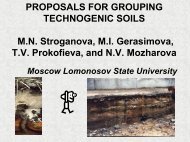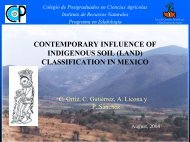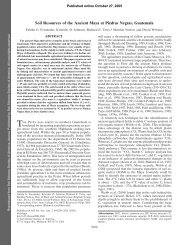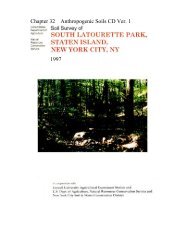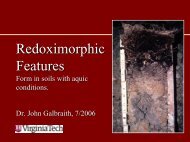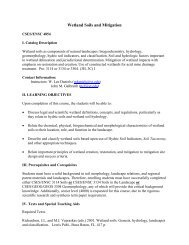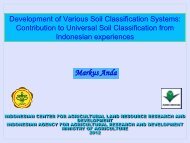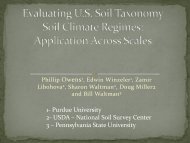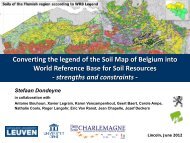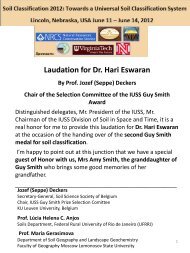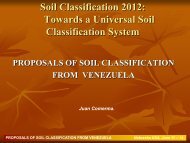Nebraska Soils Field Trip - Virginia Tech
Nebraska Soils Field Trip - Virginia Tech
Nebraska Soils Field Trip - Virginia Tech
Create successful ePaper yourself
Turn your PDF publications into a flip-book with our unique Google optimized e-Paper software.
4th IUSS Soil Classification Conference <strong>Field</strong> Tour Guidebook<br />
Draft of new section on Artifacts for the National Soil Survey Handbook,<br />
Part 618--Soil Properties and Qualities<br />
(3) Entries.—Enter innocuous or noxious in the Component Horizon Human Artifacts and Pedon<br />
Horizon Human Artifacts tables based on whether the artifacts are potentially toxic to living<br />
beings.<br />
K. Artifact Shape<br />
(1) Definition.—“Artifact Shape” is a description of the overall shape of the object.<br />
(2) Significance.—Artifact shape differs from rock, pararock, and wood fragment shape<br />
descriptions and is important for fluid flow in the soil as well as influencing excavation<br />
difficulty.<br />
(3) Classes.—The artifact shape classes are elongated, equidimensional, flat, and irregular.<br />
(4) Entries.—Enter the appropriate artifact shape class name for each record of artifacts<br />
populated in the Component Horizon Human Artifacts and Pedon Horizon Human Artifacts<br />
tables.<br />
L. Artifact Size<br />
(1) Definition.—“Artifact Size” is based on the cross-sectional diameter of the object.<br />
(2) Significance.—The size of discrete artifacts is significant to the use and management of the<br />
soil. Artifact sizes ranging from 2 mm to 75 mm that are both cohesive and persistent are<br />
considered when estimating the percent passing the sieves. It affects equipment use,<br />
excavation, construction, and recreational uses.<br />
(3) Entries.—Enter the cross-sectional diameter size of the ≥ 2 mm artifacts described in the<br />
Component Horizon Human Artifacts and Pedon Horizon Human Artifacts tables. The range<br />
of valid entries is from 2 to 3,000 millimeters, and only whole numbers (integers) are<br />
allowed.<br />
M. Artifact Volume<br />
(1) Definition.—“Artifact Volume” is the volume percentage of the horizon occupied by the 2<br />
mm or larger fraction (20 mm or larger for wood artifacts) on a whole soil base.<br />
(2) Significance.—The volume occupied by discrete artifacts (2 mm or larger fraction) is<br />
important in selecting appropriate texture modifiers (i.e., artifactual, very artifactual,<br />
extremely artifactual). Some soil horizons contain combinations of artifacts and rock<br />
fragments. See Section 618.70 H. (iv) for guidance in assigning either single (artifact only),<br />
compound (artifact and rock fragment), or dual (rock fragment-artifact) texture modifiers for<br />
horizons containing artifacts.<br />
(3) Entries.—Enter the high, low, and representative values for the percent volume present of<br />
each size class and kind of artifact populated in the Component Horizon Human Artifacts and<br />
Pedon Horizon Human Artifacts tables. The range of valid entries is from 0 to 100 percent,<br />
and only whole numbers (integers) are allowed.<br />
141



